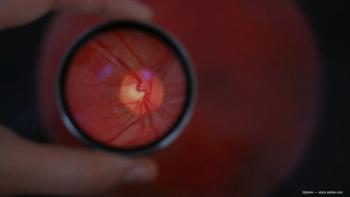
- Ophthalmology Times: June 15, 2020
- Volume 45
- Issue 10
Minimally invasive glaucoma shunt delivers for patients
Another option for ophthalmologists, gelatin stent is found to lower pressure
The first minimally invasive
The Xen stent is a 6-mm long hydrophilic gelatin stent, with an inner diameter of 45 micrometers.
It is inserted with a preloaded injector, through a corneal incision, and exits into the subconjunctival space to form a bleb. Usually, mitomycin C is injected prior to stent insertion.
Related:
Usage
The insertion can be performed as a standalone procedure or combined with
In the United States, Xen is licensed as a treatment for refractory glaucoma in cases where previous glaucoma surgery may have failed or in cases that have become nonresponsive to maximum tolerated medical therapy.
In Europe, however, the stent was launched for use as a primary surgical intervention that may prevent or delay the need for trabeculectomy and that can be performed at the same time as
Hari Jayaram, MD, PhD, of the Glaucoma Service at Moorfields Eye Hospital in London, recently presented the results of a study of 7 years of data on surgical experience at Moorfields.
The majority of the cases were of the second type mentioned above, as a primary intervention, which indicates that Xen is suited to primary open-angle glaucoma (POAG) when drops are not enough or previous medical treatments have failed.
Related:
Study design
The investigators performed a retrospective review of all ab-interno Xen procedures that had been performed at Moorfields.
In extracting the data, they paid special attention to the patient’s ethnic origin and primary underlying diagnosis, their
They also looked at the incidence of complications, in particular hypotony and infection, as well as loss of vision.
Failure was determined using a generous composite outcome, including an
Outcomes measured included whether or not a patient was using drops, and failure also included reoperation for glaucoma, endophthalmitis, or loss of light perception vision. Importantly, the need for bleb needling was not included among the criteria for failure.
Related: Pharmacologic treatment an option for treating glaucoma
The study looked at Xen insertions performed at Moorfields from May 2012 to June 2019. This included a total of 426 eyes from 375 patients.
Five percent of the patients had undergone prior
There was a wide age range of patients receiving the stents, from 16 to 95 years, with a mean age of 67. The patient population was typical of the ethnic diversity seen in London, with around 44% of patients coming from nonwhite British ancestry.
Sixty percent of the cases were performed as standalone procedures and 40% were combined with
Related: Sustained-release implant offers long-term IOP control, preserved visual function
Results
The graph at left shows the long-term outcomes, using the above-mentioned definition for failure. At 1 year, 64% of the procedures were found to be successful. This reduced to 41% after 4 years.
One interesting thing noted by the investigators is that almost a third of patients failed within the first postoperative year.
Comparing standalone to combined surgeries showed no significant difference in the survival curve of the 2 groups.
The researchers also looked at the impact of ethnicity. Patients of nonwhite British ancestry showed a trend in increase in late failure, but when viewed over the entire time course this did not reach statistical significance.
The authors believe this is in keeping with the understanding that there is a more aggressive wound healing response in these ethnic groups. However, when successful, and further
Related: The dropless future: SLT as a first-line treatment for glaucoma
Medication reduction
There was a mean reduction in medication use from 3 drops prior to surgery to about 1.3 drops over long-term follow-up in patients classified as successes.
In terms of achieving drop independence, about 40% of patients who did not require further
Complications
Hypotony occurred in about 1 in 5 patients but responded well to conservative management.
There was only 1 case of cleft formation that required surgical intervention. Bleb needling was very common, with 26% of patients needing at least 1 bleb needling procedure within the first 3 months after
The need for further
Related: Pearls for conducting GATT in open-angle glaucoma
Infection rate
The overall infection rate was 1.6%. This is lower than that reported in the trabeculectomy group in the Tube Versus Trabeculectomy (TVT) Study (NCT00306852), which was 1.9%.
However, it is higher than for all ocular
Conclusion
The authors concluded that when stent insertion is successful, and further revision
They noted, however, that surgeons should be aware of potentially high rates of reoperation and the long-term risks of bleb-related infection, and said that refining surgical technique and careful patient selection in the future may help optimize outcomes.
Read more by Steve Lenier
Hari Jayaram, MD, PhD
e: [email protected]
Dr Jayaram has no financial disclosurers related to this content.
Articles in this issue
Newsletter
Don’t miss out—get Ophthalmology Times updates on the latest clinical advancements and expert interviews, straight to your inbox.









































